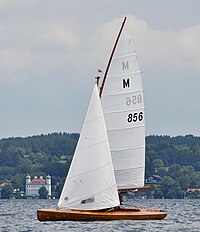M-dinghy
| Notation | |
|---|---|

|
|
| Boat dimensions | |
| Length above : | 6.00–7.50 m |
| Width above sea level : | 1.50-1.80 m |
| Sail area | |
| Sail area close to the wind : | 15 m² |
| Others | |
| Rigging type: | gaff |
| Yardstick number : | 106-108 |
| Class : | national |
The 15 m² racing dinghy, also known as the M dinghy because of its sailing mark , is a dinghy class established by the German Sailing Association in 1914. This two-man dinghy is a construction class in which only the sail area and the minimum material thickness of the wooden hull are determined by building regulations.
history
In a short time, this class developed into a popular type of boat, as it made ambitious sailing possible at a relatively low acquisition cost. The M-Jolle offered the designers a playground for new ideas. It was not uncommon for the designers to implement their designs in their own shipyard, so well-known names such as Willy Lehmann, Harry Wustrau and Reinhardt Drewitz can be found in the registration lists of the regattas around 1930. In the financially difficult time between the two world wars, many boats were built in addition to the shipyard buildings (for instructions see Maier-Verlag, Ravensburg, "Spiel und Arbeit", Volume 101, "15-m² sailing dinghy (regatta)" and volume 168 "Rennsegeljolle" )
hull
While the shape of the hull initially resembled a keelboat, the development continued to that of a pure glider. When the sailing business was resumed after the end of the First World War , the successful boats were about 6 meters long, in the following years longer and faster boats were drawn and built. Until the beginning of the Second World War put an end to the development, the fast regatta boats were longer than 7 meters. In order to keep the weight of the boats as low as possible, the light Gabon ( okoumé ) was the preferred material ; in individual cases, cedar or oak wood was also used for the planking .
Rigging, rigging, sails
In 1914, cat sails were still considered the fastest variant. The development quickly switched to rigging with a steeply set gaff sail , in which the foresail could widely overlap the mast without this being taken into account in the measured sail area . As in other classes, fully battened mainsails were used as part of the further development. The rigging could not prevail in the M dinghy class, one reason may be that the regatta courses that were sailed at the time had fewer cross courses and therefore hardly offered any advantages for this form. To save weight, hollow spars were increasingly used.
Sporting development
Over the years, a large fleet of M-dinghies has emerged, the individual associations - DSVb (German Sailing Association), DSB (German Sailing Association) and FSV ( Free Sailing Association ) - organized class regattas within the association with active participation. With the invitation to the 1st German Sailing Championship in 1930 for 15 m² racing dinghies on the Müggelsee, the DSB took advantage of the attractiveness of this class and for the first time organized a cross-association regatta against much opposition, which became a permanent institution as the German championships. The following years were, as for the other national inland racing classes, a heyday that only ended with the Second World War. Of well over 500 M dinghies, only about 60 survived the chaos of war and later confiscation. Individual newbuildings are documented from 1949 on, among other places, at Ratzeburger See, but this was not enough to revitalize the class, as the new internationally sailed dinghy classes, such as Pirate, FD and 470, represented an attractive and cheaper alternative due to their construction.
